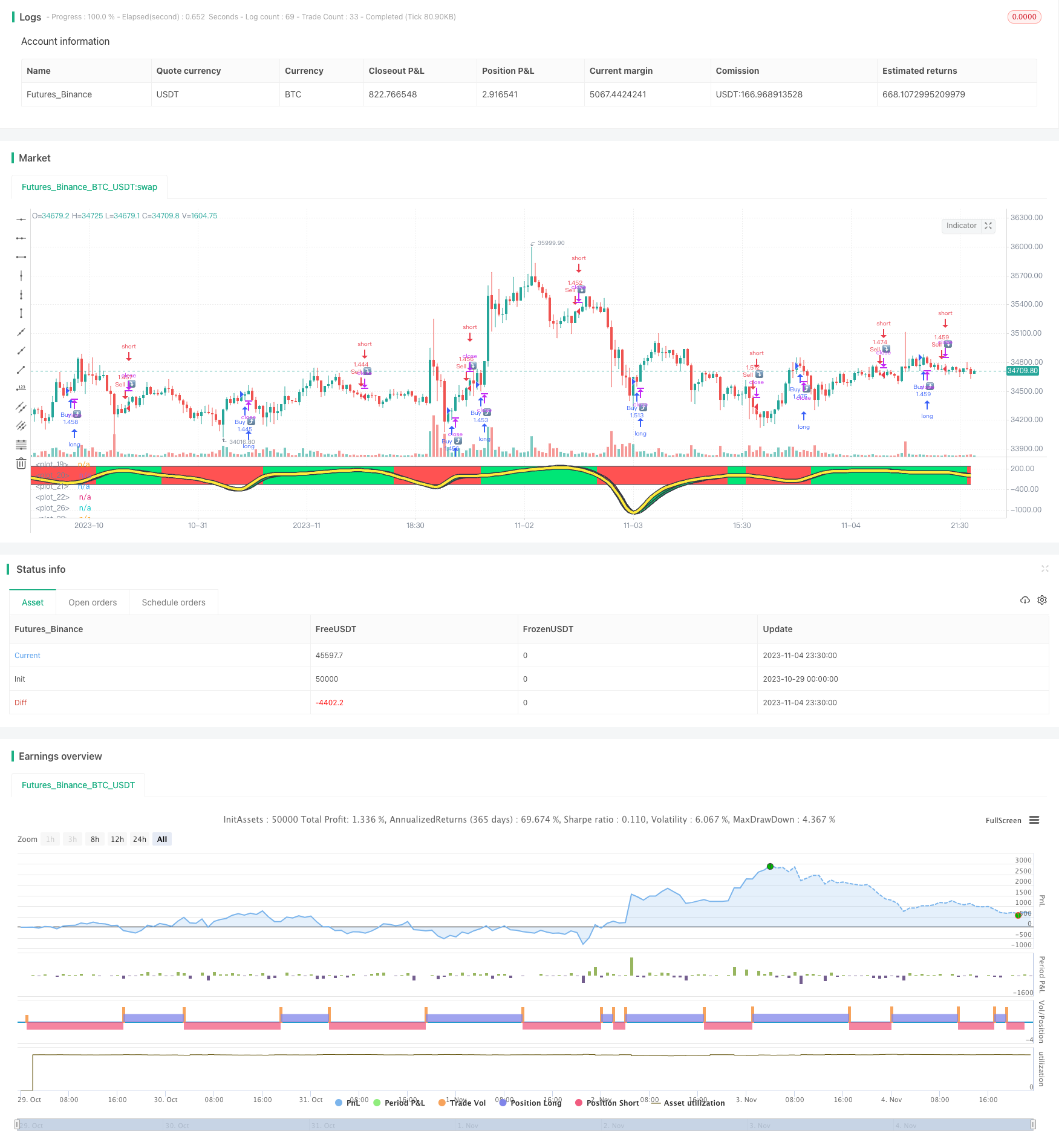이동 평균 전략의 트렌드 오차 지수
저자:차오장, 날짜: 2023-11-06 14:46:40태그:

전반적인 설명
이 전략은 가격의 트렌드 오차 지수 (TSI) 를 계산하고, 이동 평균과 TSI를 처리하고, TSI의 이동 평균 라인을 형성합니다. 가격 촛불 방향과 결합하여 현재 가격이 상승 추세 또는 하락 추세인지 결정하고, 따라서 구매 및 판매 신호를 생성합니다.
원칙
이 전략의 주요 단계는 다음과 같습니다.
- 가격 변화 비율을 계산합니다.
- HMA와 함께 이중 매끄러운 pct를 얻으려면 double_smoothed_pc
- 절대 pct의 이중 HMA를 계산하여 double_smoothed_abs_pc를 얻습니다.
- 계산 TSI 값: (100 * (double_smoothed_pc / double_smoothed_abs_pc))
- HMA와 함께 TSI 값을 처리하여 TSI 이동 평균 라인 tsihmaline를 얻으십시오.
- TSI 값과 TSI 이동 평균 라인을 비교합니다. 이동 평균의 위는 상승 추세이고 아래는 하락 추세입니다.
- 상승 추세에서, 가격도 상승하는 경우, 구매 신호를 생성
- 하락 추세에서, 가격도 떨어지고 있다면, 판매 신호를 생성
위의 단계를 통해 전체 트렌드 방향을 결정하고 실제 가격 움직임과 결합하여 거래 신호를 생성합니다.
장점
- 이중 HMA 평평화 단기 소음 및 주요 트렌드 잠금 필터
- TSI와 그 이동평균선은 전반적인 경향 방향을 결정합니다.
- 가격 촛불과 결합하면 가짜 브레이크오웃을 피하고 신호 신뢰성을 향상시킵니다.
- 사용자 정의 가능한 매개 변수는 다른 사이클 시장에 적응합니다
- 그래픽 시각화, 상승 추세를 표시하는 녹색, 하락 추세를 표시하는 빨간색
위험성
- 범위에 묶인 시장에서 여러 가지 잘못된 신호를 생성 할 수 있습니다.
- 전환점에서의 이동평균선 지연, 아마도 가장 좋은 입문 지점을 놓치고 있습니다.
- 변화하는 시장에 적응하기 위해 자주 매개 변수를 조정해야합니다.
- 단일 TSI 지표에 기초하여 다른 지표와 최적화 할 수 있습니다.
강화
- 통합 중에 잘못된 신호를 피하기 위해 필터를 추가
- 트렌드 반전 지점을 확인하기 위해 다른 지표를 추가합니다.
- 기계 학습 등을 통해 매개 변수를 자동 최적화
- 단일 거래 손실을 통제하기 위해 스톱 손실을 도입하십시오.
결론
이 전략은 트렌드 방향을 결정하기 위해 TSI를 사용하여 가격 촛불과 결합하여 트렌드를 효과적으로 파악하고 상승 추세에서 구매하고 하락 추세에서 판매 할 수있는 거래 신호를 생성합니다. 그러나 안정성을 향상시키기 위해 최적화를 필요로하는 위험도 있습니다. 전반적으로이 전략은 직관적이고 이해하기 쉽습니다. 기술 지표에 익숙한 거래자에게 적합합니다.
/*backtest
start: 2023-10-29 00:00:00
end: 2023-11-05 00:00:00
period: 30m
basePeriod: 15m
exchanges: [{"eid":"Futures_Binance","currency":"BTC_USDT"}]
*/
//@version=4
strategy(title="TSIHULLBOT", shorttitle="TSICCIHULL", default_qty_type=strategy.percent_of_equity, default_qty_value=100)
long = input(title="Long Length", type=input.integer, defval=50)
short = input(title="Short Length", type=input.integer, defval=50)
signal = input(title="Signal Length", type=input.integer, defval=7)
price = input(title="Source",type=input.source,defval=open)
lineupper = input(title="Upper Line", type=input.integer, defval=250)
linelower = input(title="Lower Line", type=input.integer, defval=-250)
double_smooth(price, long, short) =>
fist_smooth = hma(price, long)
hma(fist_smooth, short)
pc = change(price)
double_smoothed_pc = double_smooth(pc, long, short)
double_smoothed_abs_pc = double_smooth(abs(pc), long, short)
tsi_value = (100 * (double_smoothed_pc / double_smoothed_abs_pc))*5
tsihmaline=(hma(tsi_value,signal))*5
clr = tsihmaline < tsi_value ? color.red : color.lime
clr2 = tsi_value < tsi_value[1] ? color.red : color.lime
i1=plot(lineupper+3, color=color.black, linewidth=3)
i2=plot(linelower+3, color=color.black, linewidth=3)
i3=plot(lineupper, color=clr)
i4=plot(linelower, color=clr)
trendv=tsihmaline/5.6
plot(trendv, linewidth=7, color=color.black)
plot(trendv, linewidth=4, color=color.yellow)
j1=plot(tsi_value, linewidth=5, color=color.black)
j2=plot(tsi_value[1], linewidth=5, color=color.black)
j3=plot(tsi_value, color=clr2)
j4=plot(tsi_value[1], color=clr2)
fill(i3,i4,color=clr,transp=90)
fill(j3,j4,color=clr2,transp=15)
longCondition = tsihmaline>tsihmaline[1] and price>price[1]
if (longCondition)
strategy.entry("Buy ⤴️", strategy.long)
shortCondition = tsihmaline<tsihmaline[1] and price<price[1]
if (shortCondition)
strategy.entry("Sell ⤵️", strategy.short)
더 많은
- RSI 범위 거래 전략
- 양극성 월간 수익 전략
- 멀티 타임프레임 이동 평균 모멘텀 거래 전략
- 이동 평균 크로스오버 거래 전략의 추세
- 돈치안 채널 트렌드 추적 전략
- 큰 파동, 큰 추락 전략
- 분자 오시레이터 전략
- 트렌드 추적 전략과 함께 두 개의 이동 평균 채널
- 월요일 반전 Intraday 트렌드 전략
- ADX 필터드
데 크롤 스톱 로스 트렌드 전략 - 모멘텀 통합 지표 전략
- MACD 이동 평균 크로스오버 트렌드
- 두 가지 트렌드 포착 융합 전략
- 가격 돌파구 볼링거 밴드 A 전략
- ROC 거래 전략에 기초한 RSI
- 어제의 높은 탈출 전략
- 전략 을 따르는 경향
- 평형 이동 평균 전략
- 이중 이동 평균 크로스오버 트렌드 거래 전략
- 코네티컷 거북이 시스템